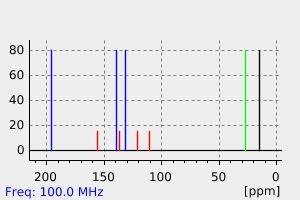3-溴-5-乙基-2-羟基苯甲醛 | 708209-58-9
中文名称
3-溴-5-乙基-2-羟基苯甲醛
中文别名
——
英文名称
3-bromo-5-ethylsalicylaldehyde
英文别名
3-Bromo-5-ethyl-2-hydroxybenzaldehyde
CAS
708209-58-9
化学式
C9H9BrO2
mdl
——
分子量
229.073
InChiKey
XDAJAIJDFVGPAK-UHFFFAOYSA-N
BEILSTEIN
——
EINECS
——
-
物化性质
-
计算性质
-
ADMET
-
安全信息
-
SDS
-
制备方法与用途
-
上下游信息
-
文献信息
-
表征谱图
-
同类化合物
-
相关功能分类
-
相关结构分类
计算性质
-
辛醇/水分配系数(LogP):3.1
-
重原子数:12
-
可旋转键数:2
-
环数:1.0
-
sp3杂化的碳原子比例:0.22
-
拓扑面积:37.3
-
氢给体数:1
-
氢受体数:2
安全信息
-
海关编码:2913000090
上下游信息
-
上游原料
中文名称 英文名称 CAS号 化学式 分子量 5乙基-2-羟基苯甲醛 5-ethyl-2-hydroxybenzaldehyde 52411-35-5 C9H10O2 150.177
反应信息
-
作为反应物:描述:3-溴-5-乙基-2-羟基苯甲醛 、 (1R,2R)-1,2-diaminocyclohexane 以 乙醇 为溶剂, 反应 2.0h, 以66%的产率得到(R,R)-(-)-N,N'-bis(3-bromo-5-ethylsalicylidene)-trans-cyclohexane-1,2-diamine参考文献:名称:Ligand tuning in the chromium–salen-mediated asymmetric epoxidation of alkenes摘要:A series of Cr(salen) complexes have been synthesised from 5-substituted-3-bromosalicylaldehydes and trans-1,2-cyclohexanediamine. These have been used to probe the Cr(salen)-mediated asymmetric epoxidation of alkenes. No simple correlation was found between the electronic character of the salen-substituents and the enantioselectivity-multiple oxidation pathways are proposed as a possible explanation. Enantioselectivities of Lip to 90% have been achieved using a novel, synthetically accessible Cr(salen) complex. (C) 2004 Elsevier Ltd. All rights reserved.DOI:10.1016/j.tetasy.2004.03.010
-
作为产物:描述:4-乙基苯酚 在 溴 、 sodium acetate 、 magnesium methanolate 、 溶剂黄146 作用下, 以 甲醇 为溶剂, 反应 16.0h, 生成 3-溴-5-乙基-2-羟基苯甲醛参考文献:名称:Ligand tuning in the chromium–salen-mediated asymmetric epoxidation of alkenes摘要:A series of Cr(salen) complexes have been synthesised from 5-substituted-3-bromosalicylaldehydes and trans-1,2-cyclohexanediamine. These have been used to probe the Cr(salen)-mediated asymmetric epoxidation of alkenes. No simple correlation was found between the electronic character of the salen-substituents and the enantioselectivity-multiple oxidation pathways are proposed as a possible explanation. Enantioselectivities of Lip to 90% have been achieved using a novel, synthetically accessible Cr(salen) complex. (C) 2004 Elsevier Ltd. All rights reserved.DOI:10.1016/j.tetasy.2004.03.010
文献信息
-
N-(4- carbamimidoyl-phenyl) -glycine derivatives申请人:——公开号:US20010001799A1公开(公告)日:2001-05-24The invention is concerned with novel N-(4-carbamimidoyl-phenyl)-glycine derivatives of the formula: 1 wherein R 1 , E, X 1 to X 4 and G 1 and G 2 are as defined in the description and the claims, as well as hydrates or solvates and physiologically usable salts thereof.
-
N- (4-carbamimidoyl-phenyl) -glycine derivatives申请人:——公开号:US20030083504A1公开(公告)日:2003-05-01The invention is concerned with novel N-(4-carbamimidoyl-phenyl)-glycine derivatives of the formula: 1 wherein R 1 , E, X 1 to X 4 and G 1 and G 2 are as defined in the description and the claims, as well as hydrates or solvates and physiologically usable salts thereof.
-
PHENYLGLYCINE DERIVATIVES申请人:F. HOFFMANN-LA ROCHE AG公开号:EP1149069A1公开(公告)日:2001-10-31
-
US6242644B1申请人:——公开号:US6242644B1公开(公告)日:2001-06-05
-
US6476264B2申请人:——公开号:US6476264B2公开(公告)日:2002-11-05
表征谱图
-
氢谱1HNMR
-
质谱MS
-
碳谱13CNMR
-
红外IR
-
拉曼Raman
-
峰位数据
-
峰位匹配
-
表征信息
同类化合物
(反式)-4-壬烯醛
(s)-2,3-二羟基丙酸甲酯
([1-(甲氧基甲基)-1H-1,2,4-三唑-5-基](苯基)甲酮)
(Z)-4-辛烯醛
(S)-氨基甲酸酯β-D-O-葡糖醛酸
(S)-3-(((2,2-二氟-1-羟基-7-(甲基磺酰基)-2,3-二氢-1H-茚满-4-基)氧基)-5-氟苄腈
(R)-氨基甲酸酯β-D-O-葡糖醛酸
(5,5-二甲基-2-(哌啶-2-基)环己烷-1,3-二酮)
(2,5-二氟苯基)-4-哌啶基-甲酮
龙胆苦苷
龙胆二糖甲乙酮氰醇(P)
龙胆二糖丙酮氰醇(P)
龙胆三糖
龙涎酮
齐罗硅酮
齐留通beta-D-葡糖苷酸
鼠李糖
黑芥子苷单钾盐
黑海棉酸钠盐
黑木金合欢素
黑曲霉三糖
黑介子苷
黄尿酸8-O-葡糖苷
麻西那霉素II
麦迪霉素
麦芽糖脎
麦芽糖基海藻糖
麦芽糖1-磷酸酯
麦芽糖
麦芽四糖醇
麦芽四糖
麦芽十糖
麦芽六糖
麦芽五糖水合物
麦芽五糖
麦芽五糖
麦芽五糖
麦芽三糖醇
麦芽三糖
麦芽三糖
麦芽三塘水合
麦芽七糖水合物
麦芽七糖
麦法朵
麦可酚酸-酰基-Β-D-葡糖苷酸
麦利查咪
麝香酮
鹤草酚
鸢尾酚酮 3-C-beta-D-吡喃葡萄糖苷
鸡矢藤苷







